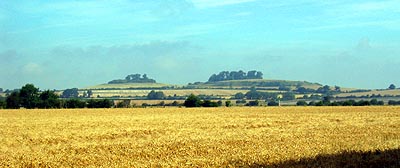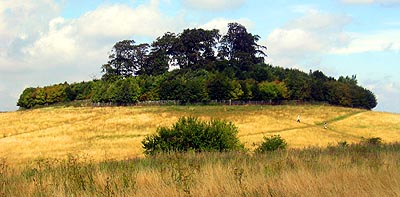 |
 |
|||
|
|
 Wittenham
Clumps Wittenham
ClumpsLittle Wittenham, Berkshire The tree-covered heights of the Iron Age Hillfort on Sinodun (or Castle) Hill and its twin, both in Little Wittenham, are a well-known beauty spot known variously as Wittenham Clumps, the Berkshire Bubs or Mother Dunch's Buttocks! The name Sinodun is pure Celtic. Seno-Dunum means 'Old Fort'. This may indicate it was abandoned quite some time before the Romans arrived in Berkshire or, more likely, that it was so-named in the post-Roman period, before the Saxons arrived. Excavations have shown that a
late Bronze Age sub-circular enclosure surrounded the first hectare of
settlement on the site. It had a 2.5m deep U-shaped ditch and associated
bank, possibly with a palisade on top. The early Iron Age saw the building
of the banks and 7.5m deep V-shaped ditches forming the hillfort of today.
There was a rampart with both timber palisades and revetment. No round
houses have been discovered so far, but the inhabitants, who were largely
resident in the middle Iron Age, are known to have eaten fish from Thames
and wild boar from the woods, whilst farming some cattle, but mostly sheep.
Barley and some wheat was grown in the surrounding fields and stored here in
huge pits. Other activities in evidence include sewing (with bone needles)
and spinning (with spindle whorls). Unusually for the Iron Age, a number of
burials were discovered - one in a grave, the others in pits. The most
significant consisted of a large male buried in the foetal position at the
bottom of a pit, a charred grain deposit at his feet and joints of meat
under his arm. After a covering of earth, the better part of a dismembered
|
|||
| © Nash Ford Publishing 2004. All Rights Reserved. The location of this site is now administered by Oxfordshire County Council. | ||||



 female
was placed on top of him. The final covering included the body of a sheep.
All were deposited at one go and it has been suggested that the cut marks on
the female bones indicate she was a human sacrifice, as described by Roman
writers. There appears to have been no occupation in the late Iron Age, but
Roman rubbish dumping corresponds with the establishment of one, if not two,
Roman buildings in large enclosures, to the south-west. Rectangular
features, upwards of 3m wide, also date from this period. They appear to be
water storage tanks associated with nearby springs. No evidence of Saxon
occupation has been found, but King Offa of Mercia apparently built some
sort of look-out post at Sinodun, after defeating the West Saxons at the
Battle of Benson in AD 772.
female
was placed on top of him. The final covering included the body of a sheep.
All were deposited at one go and it has been suggested that the cut marks on
the female bones indicate she was a human sacrifice, as described by Roman
writers. There appears to have been no occupation in the late Iron Age, but
Roman rubbish dumping corresponds with the establishment of one, if not two,
Roman buildings in large enclosures, to the south-west. Rectangular
features, upwards of 3m wide, also date from this period. They appear to be
water storage tanks associated with nearby springs. No evidence of Saxon
occupation has been found, but King Offa of Mercia apparently built some
sort of look-out post at Sinodun, after defeating the West Saxons at the
Battle of Benson in AD 772.